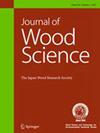Composition analysis of exudates produced by conifers grown in Taiwan and their antifungal activity
IF 2.4
3区 农林科学
Q2 FORESTRY
引用次数: 0
Abstract
Exudates are involved in the defense mechanism of trees; they could work against insects or microorganisms through a physical or chemical system. The main components of exudates are terpenoids. This study identified the main compounds of exudates from 13 conifers of Taiwan using gas chromatogram–mass spectrometry (GC–MS) and spectroscopic analysis. The results revealed that the main volatiles were α-pinene, β-ocimene, β-pinene, sabinene, and caryophyllene. On the other hand, the main nonvolatile compounds were diterpenoids, which were classified into three skeletons (abietane-, labdane-, and pimarane-types). Among these, abietane-type presented in Pinaceae and in most of Cupressaceae; labdane-type presented in Pinaceae and in all of Cupressaceae and Araucariaceae; pimarane-type existed in both Pinaceae and Cupressaceae. Furthermore, the epigenetics of conifers analysis results by GC–MS and heteronuclear single quantum coherence (HSQC) of nuclear magnetic resonance (NMR) fingerprints were similar to traditional taxonomy classification; it indicated that exudates chemotaxonomy by using GC–MS and HSQC profiling is a useful technology to classify the conifers. Besides, the exudates of Pinus elliottii, Pinus taiwanensis, Calocedrus macrolepis and Chamaecyparis formosensis possessed the strong antifungal activity. For white-rot fungus, Trametes versicolor, Pinus morrisonicola, Chamaecyparis obtusa, and Araucaria heterophylla exhibited the higher antifungal index. For brown-rot fungus, Laetiporus sulphureus, Pinus elliottii, Pinus morrisonicola, and Chamaecyparis formosensis revealed a good antifungal activity.台湾针叶树分泌物成分分析及抑菌活性
分泌物参与树木的防御机制;它们可以通过物理或化学系统来对抗昆虫或微生物。渗出物的主要成分为萜类化合物。本研究采用气相色谱-质谱联用及光谱分析方法,鉴定了台湾13种针叶树渗出物的主要成分。结果表明,主要挥发物为α-蒎烯、β-辛烯、β-蒎烯、沙滨烯和石竹烯。另一方面,主要的非挥发性化合物为二萜,可分为三种骨架(阿比烷型、labdane型和海马兰烷型)。其中,枞烷型主要存在于松科和大部分柏科;松科、柏科、杉木科均有labdane型;松科和柏科均存在海马兰型。此外,通过GC-MS和核磁共振指纹图谱的异核单量子相干(HSQC)对针叶树的表观遗传学分析结果与传统的分类方法相似;说明气相色谱-质谱和HSQC分析是针叶树分泌物化学分类的有效方法。此外,湿地松、台湾松、大松和台湾沙杉的分泌物具有较强的抗真菌活性。对白腐菌的抑菌指数较高的是彩木栓、松、长尾木和异叶木栓。对褐腐菌有较强的抑菌活性,其中硫化松、油松、松、台杉有较好的抑菌活性。
本文章由计算机程序翻译,如有差异,请以英文原文为准。
求助全文
约1分钟内获得全文
求助全文
来源期刊

Journal of Wood Science
工程技术-材料科学:纸与木材
CiteScore
5.40
自引率
10.30%
发文量
57
审稿时长
6 months
期刊介绍:
The Journal of Wood Science is the official journal of the Japan Wood Research Society. This journal provides an international forum for the exchange of knowledge and the discussion of current issues in wood and its utilization. The journal publishes original articles on basic and applied research dealing with the science, technology, and engineering of wood, wood components, wood and wood-based products, and wood constructions. Articles concerned with pulp and paper, fiber resources from non-woody plants, wood-inhabiting insects and fungi, wood biomass, and environmental and ecological issues in forest products are also included. In addition to original articles, the journal publishes review articles on selected topics concerning wood science and related fields. The editors welcome the submission of manuscripts from any country.
 求助内容:
求助内容: 应助结果提醒方式:
应助结果提醒方式:


